The role of scope caps extends far beyond mere protection, as they also contribute to an enhanced user experience, facilitating quick target acquisition and ensuring the optical clarity required in various activities like hunting, shooting sports, wildlife observation, and more. From preventing dust and debris intrusion to safeguarding against harsh weather conditions, scope caps are silent heroes, enabling optical devices to perform at their best when it matters most.
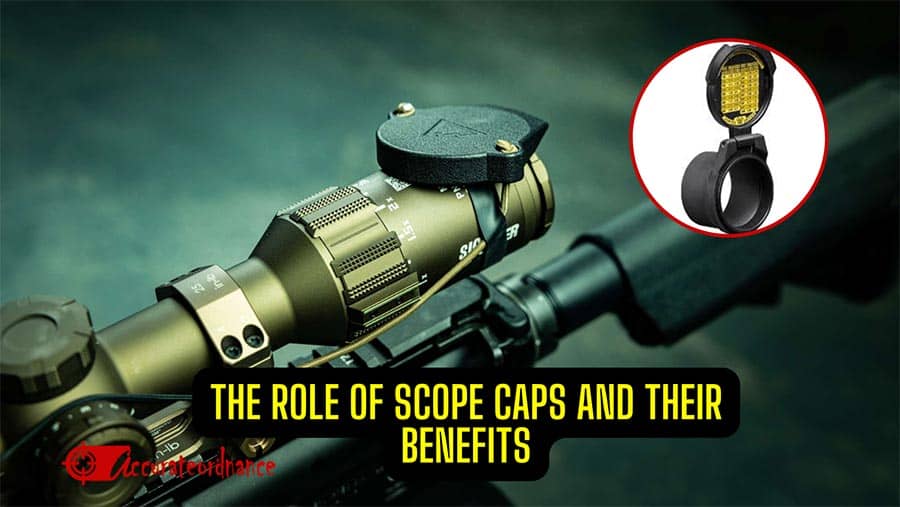
- Definition and Function
- Types of Scope Caps
- Components and Construction of Scope Caps
- Scope Cap Sizes and Compatibility
- Benefits of Using Scope Caps
- Choosing the Right Scope Caps
- Notable Brands and Products
- FAQs
- Are scope caps universal or do they come in different sizes?
- Can I use scope caps on any type of riflescope?
- How can I remove and install scope caps without damaging my scope?
- Are there any alternatives to scope caps for protecting my riflescope?
- Can scope caps affect the accuracy of my shots?
- How often should I replace my scope caps?
Definition and Function
Scope caps, also known as lens caps or objective covers, are protective accessories designed to safeguard the lenses and critical components of optical instruments, such as riflescopes, binoculars, spotting scopes, and cameras. These caps serve a fundamental purpose in the world of optics: They shield delicate lenses and reticles from potential harm, ensuring that your optical device continues to deliver crisp, clear images and accurate aiming.
The primary functions of scope caps include:
Protection: Scope caps act as a physical barrier, safeguarding the lenses from various environmental hazards like dust, dirt, debris, moisture, and impacts. By keeping these elements at bay, they prevent scratches, smudges, and damage that could compromise optical performance.
Quick Access: Many scope caps are designed for quick and easy access. Some feature flip-up mechanisms that allow you to swiftly open the caps, facilitating rapid target acquisition without the need for removing the caps entirely.
Weatherproofing: In outdoor settings, exposure to rain, snow, and humidity can be detrimental to lenses. Scope caps help maintain a dry and clear optical path, ensuring that adverse weather conditions don’t hinder your viewing or targeting capabilities.
Types of Scope Caps
Scope caps come in various types and designs to cater to different preferences and requirements. Some common types of scope caps include:
Flip-Up Caps
These are hinged caps that can be flipped open with a simple touch. They are popular for their convenience and quick access to the optics. When not in use, flip-up caps can be closed securely to protect the lenses.
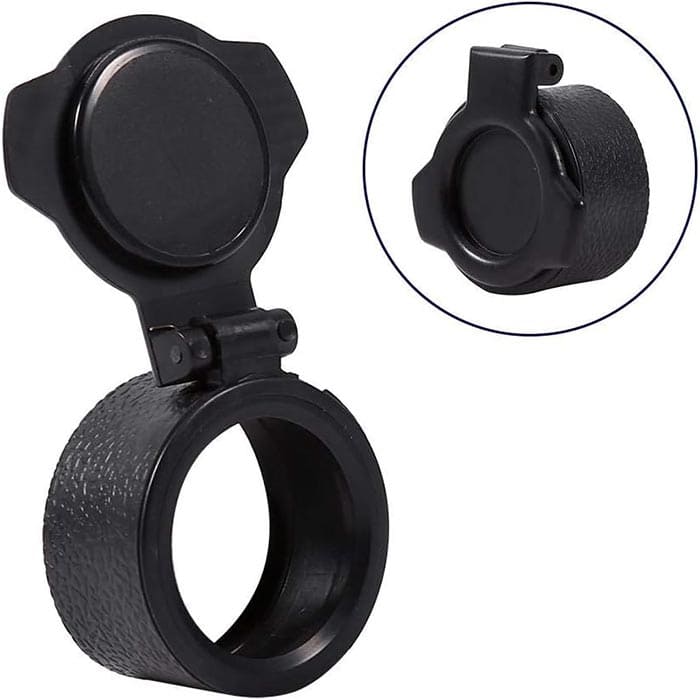
Threaded Caps
Threaded caps screw onto the threads provided around the objective lens or ocular lens. They provide a secure and airtight seal, offering robust protection against dust, moisture, and impacts.
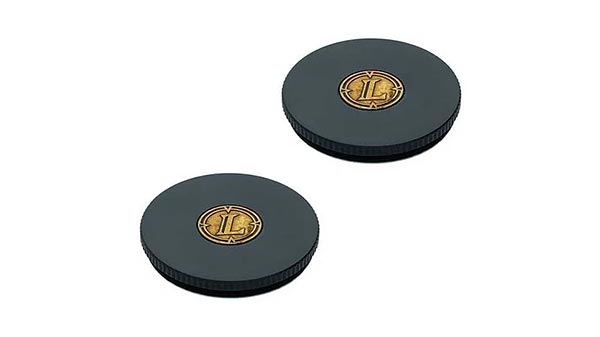
Objective Covers
Objective covers are designed to protect the front (objective) lens of an optical device. They come in various sizes and are often tethered to the scope or binoculars with elastic cords, making them easy to remove and replace.
Eyepiece Covers
Eyepiece covers serve a similar purpose but are designed for the eyepiece or ocular lens of an optical instrument. They are especially common in binoculars and spotting scopes.
Custom Fit Caps
Some scope caps are custom-made to fit specific models of optics perfectly. These caps offer a tailored and snug fit, ensuring maximum protection.
Universal Caps
Universal scope caps are designed to fit a range of optics within a certain size category. While they may not offer the same level of precision fit as custom caps, they provide versatility for users with multiple devices.
Transparent Caps
Transparent scope caps are made of clear materials, allowing you to keep the caps on while still viewing through the lens. These are often used in situations where you need constant protection but also want to monitor your surroundings.

Components and Construction of Scope Caps
Understanding the components and construction of scope caps is essential for appreciating their durability, functionality, and suitability for different applications. In this section, we will explore the materials used in scope cap manufacturing and the design features that make them indispensable accessories for optical instruments.
Materials Used
a. Plastics
Many scope caps are crafted from high-quality polymer materials. These plastics are lightweight, durable, and resistant to moisture and corrosion. They provide excellent protection against impacts and are often used for flip-up caps, objective covers, and eyepiece covers.
b. Rubber
Rubber scope caps offer flexibility and shock absorption. They are known for their ability to withstand rough handling and impacts without causing damage to the optics. Rubberized caps are commonly used for eyepiece covers and flip-up caps, providing extra protection against bumps and falls.
c. Aluminum
Threaded scope caps are often constructed from aluminum. This metal offers exceptional strength and durability while remaining relatively lightweight. Aluminum caps are designed to provide a robust protection for the threaded parts of optical instruments.
d. Transparent Polycarbonate
Transparent caps are typically made from high-quality polycarbonate. This clear material allows users to keep the caps on while still maintaining visibility through the lens. It ensures that the optics remain protected while allowing constant monitoring of the surroundings.
Design Features
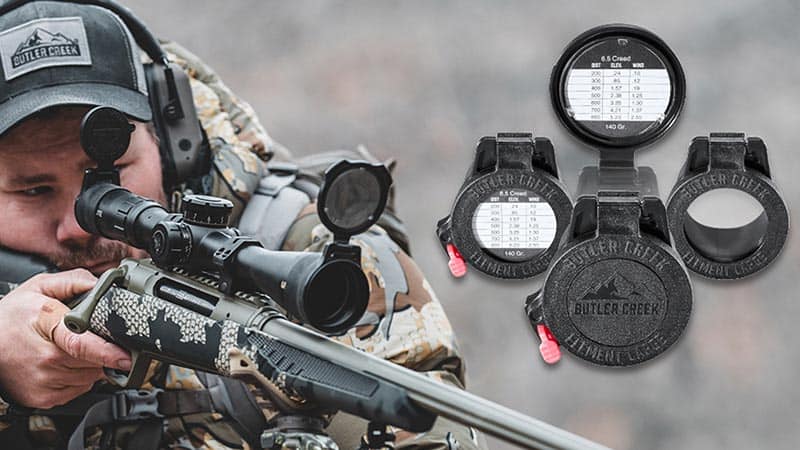
Hinges for Flip-Up Caps
Flip-up scope caps feature hinged designs that allow them to be flipped open and closed with ease. The hinge ensures that the caps stay attached to the scope, so they are never misplaced or lost. These caps are often spring-loaded for smooth operation and quick access to the optics.
Threaded Mechanisms for Threaded Caps
Threaded scope caps are designed with precision threads that screw onto the threads provided around the objective or ocular lens. This design creates a secure and airtight seal.
Elastic Cords for Objective and Eyepiece Covers:
Objective and eyepiece covers are often equipped with elastic cords that tether them to the optical device. This feature allows users to remove the covers easily when needed and ensures they remain within reach for quick replacement.
Scope Cap Sizes and Compatibility
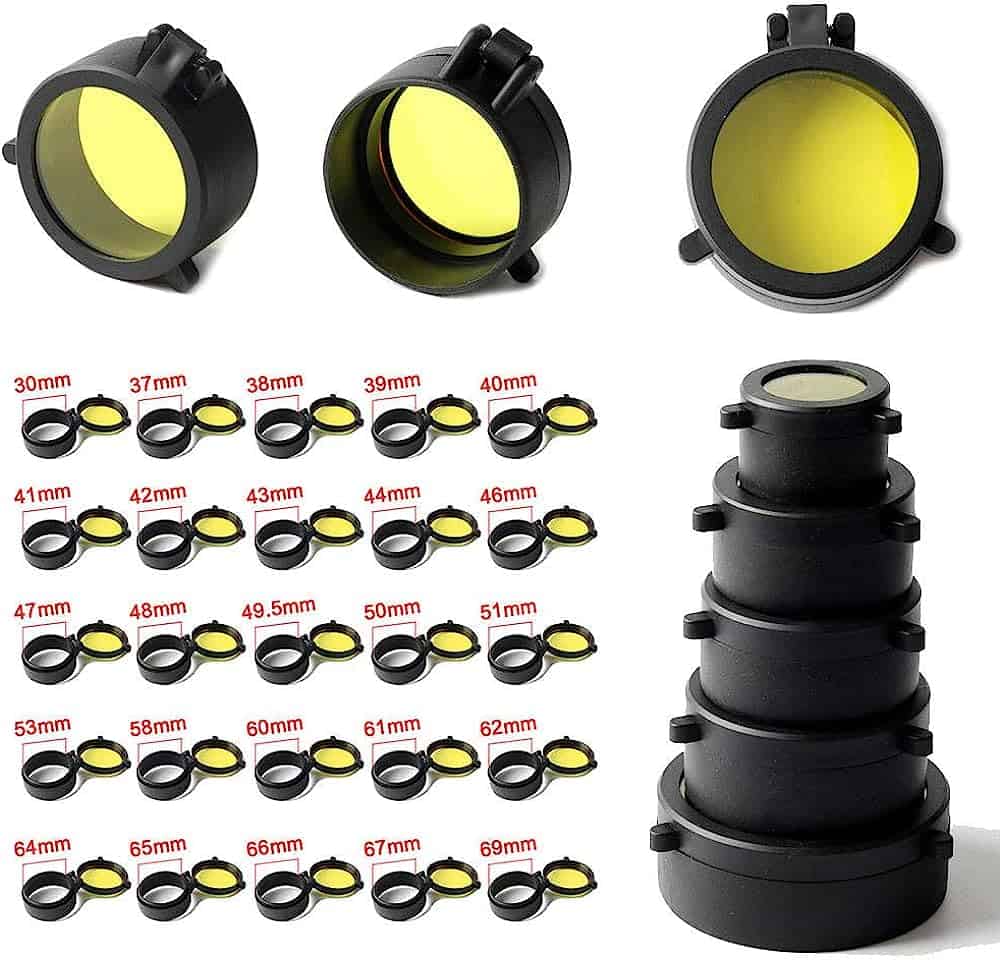
Matching Scope Cap to Scope Diameter
- Measuring the Scope Diameter
To determine the appropriate scope cap size, you need to measure the diameter of your scope’s objective lens or eyepiece. This measurement is typically expressed in millimeters and can often be found in the scope’s specifications provided by the manufacturer. Use a caliper or a ruler with millimeter markings to measure the outer diameter accurately.
- Choosing the Right Size
Once you have the measurement, choose scope caps that are designed to fit the specific diameter of your scope. Scope cap manufacturers often label their products with size indicators, making it easier for users to select the correct size. It’s essential to select caps that snugly fit your scope to ensure proper protection and functionality.
- Custom Fit Options
Some scope caps are custom-made for specific scope models, ensuring a precise fit. These custom-fit caps provide maximum protection and are ideal for users who prioritize accuracy and a seamless fit. Custom-fit options are particularly popular among professional shooters and hunters.
Considerations for Different Optics (e.g., riflescopes, binoculars)
Riflescopes
Riflescopes come in various sizes and configurations, and the choice of scope caps depends on the specific riflescope model. Tactical or long-range riflescopes with larger objective lenses will require caps designed for those dimensions. Consider flip-up caps for quick target acquisition during shooting sports or hunting, and make sure they are compatible with the scope’s magnification adjustments.
Binoculars
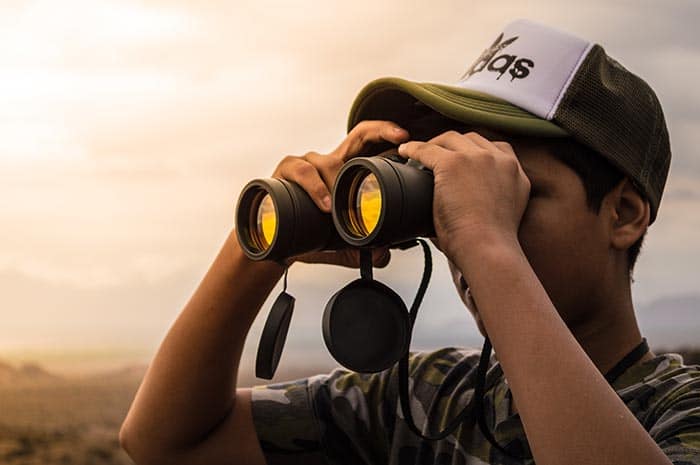
Binoculars are equipped with both objective lenses and eyepieces, and scope caps are available for both components. For binoculars, objective covers are crucial to protect the front lenses from scratches and debris. Eyepiece covers ensure that the ocular lenses remain clean and unharmed. Elastic cords on covers can be adjusted to fit various binocular sizes.
Spotting Scopes
Spotting scopes often have large objective lenses, and threaded caps or custom-fit options are popular choices to provide robust protection. Spotting scopes are commonly used in birdwatching, wildlife observation, and target shooting, and scope caps ensure that these activities can be carried out with clarity and precision.
Benefits of Using Scope Caps
Scratch and Impact Resistance
In outdoor environments or when transporting optics, lenses are susceptible to scratches and impacts. Scope caps shield the lenses from accidental bumps and scratches, preserving their integrity and preventing costly damage.
Reduced Downtime for Cleaning and Maintenance
Optics that are well-protected by scope caps require less frequent cleaning and maintenance. This not only saves time but also reduces the risk of mishandling delicate lenses during cleaning procedures. Users can spend more time enjoying their activities and less time tending to their equipment.
Quick Target Acquisition
Flip-up scope caps are designed for quick and easy access to the optics. This feature is especially valuable for hunters and competitive shooters who need to acquire targets rapidly. The ability to flip open the caps ensures that there is no delay in aiming.
Convenience in the Field
Whether you’re in the wilderness for a photography expedition, hunting, or birdwatching, scope caps add convenience. They offer a simple way to protect your optics and keep them ready for use. You don’t have to worry about removing and storing the caps separately; they are always at hand.
Preservation of Optics
By preventing damage and degradation of lenses, scope caps contribute to the longevity of optical instruments. Well-maintained optics can serve users for many years, making scope caps a cost-effective investment.
Choosing the Right Scope Caps
Selecting the appropriate scope caps is a critical decision to ensure the protection and functionality of your optical instruments. Several factors must be considered when making this choice:
Durability and Materials
Scope caps are made from various materials, including plastics, rubber, aluminum, and transparent polycarbonate. Consider the durability and resilience of the materials, especially if you anticipate using your optics in rugged or adverse environments.
Ease of Installation
Some scope caps feature quick-release mechanisms or elastic cords for easy installation and removal. Evaluate how user-friendly the caps are, particularly if you need to access your optics quickly in the field.
Budget
Scope caps come in a wide price range. Consider your budget and prioritize caps that offer the best combination of protection, convenience, and affordability for your specific needs.
Weather Conditions
Think about the typical weather conditions in which you’ll use your optics. If you anticipate exposure to rain or snow, opt for caps with weatherproofing features, such as threaded caps with an airtight seal.
Compatibility
Ensure that the scope caps you choose are compatible with the specific make and model of your optical instrument. Custom-fit caps provide the best fit but may be limited in selection. Universal caps offer versatility but may not fit as snugly. If your riflescope has variable magnification, ensure that the scope caps do not interfere with the zoom or focus adjustments. Flip-up caps should not obstruct the magnification ring.
Transparency (for Transparent Caps)
If you opt for transparent scope caps, ensure they are made from scratch-resistant and optically clear materials. Clarity is essential for maintaining visual awareness while protecting your optics.
Notable Brands and Products
To help you make informed choices, let’s explore well-known scope cap manufacturers and recommended products in both high-end and budget-friendly categories.
Leupold
Leupold, a respected name in the optics industry, manufactures scope caps designed for precision. Their Alumina Flip-Back Lens Covers are popular among shooters and hunters for their robust construction and quick-access design.
Vortex Optics
Vortex Optics is known for its exceptional optics products, and its scope caps reflect the same commitment to quality. Vortex offers a variety of caps suitable for different types of scopes, including flip-up caps for rapid target acquisition.
Trijicon
Trijicon specializes in aiming solutions and accessories for firearms, including scope caps. Their caps are designed to withstand rugged conditions and maintain the clarity of optics in various environments.
FAQs

Are scope caps universal or do they come in different sizes?
Scope caps come in various sizes to match the diameter of specific optical instruments’ lenses. They are not universal. To ensure proper protection, it’s essential to choose scope caps that fit the exact size of your scope’s objective and eyepiece lenses.
Can I use scope caps on any type of riflescope?
Scope caps are designed for use with various optical instruments, including riflescopes. However, it’s crucial to select scope caps that match the size and type of your rifle scope to ensure a proper fit and optimal protection.
How can I remove and install scope caps without damaging my scope?
To remove and install scope caps without damaging your scope: Be gentle and avoid using excessive force. Use quick-release mechanisms if available for easy installation and removal. For threaded caps, ensure they are properly aligned and gently thread them on or off.
Are there any alternatives to scope caps for protecting my riflescope?
Yes, alternatives include lens cloths, lens pens, and lens sprays for cleaning and protecting optics. However, these alternatives do not provide the same level of constant protection against dust, debris, and impacts that scope caps offer.
Can scope caps affect the accuracy of my shots?
Properly fitted scope caps should not affect the accuracy of your shots. However, it’s essential to ensure that scope caps do not obstruct the scope’s objective lens or reticle view. Align them correctly to maintain a clear sight picture.
How often should I replace my scope caps?
Scope caps are durable, but they can wear out over time, especially if exposed to harsh conditions. Inspect them regularly for signs of damage or wear, and replace them when they no longer provide adequate protection or if they become loose.

Mike Hardesty is a published freelance gun writer. He also possesses specialized expertise in rifle scopes With dozens of articles and reviews published in Pew Pew Tactical, Snipercountry.com, and TTAG (The Truth About Guns), Mike is considered a firearms expert. His special area of expertise is handguns.
Mike is a long-time shooter. He has been punching paper targets, taking deer and other game and shooting at competitions since about 1975. Other related pursuits include reloading and bullet casting. He currently reloads for over 10 calibers, both handgun and rifle. His reloads, particularly for 9mm, were in great demand during the height of the ammo shortage among family and friends. He donated hundreds of rounds to informal shooting sessions. He was quoted as saying “I do not sell my reloads but I sure will help my guys shoot ’em for free!”. He has a few cherished firearms that he has inherited or otherwise procured — those are his favorites.
He earned B.S. and M.S. degrees from Indiana State University in 1974-1975.
He’s a firearm experts and is the founder of mhardesty.com.
